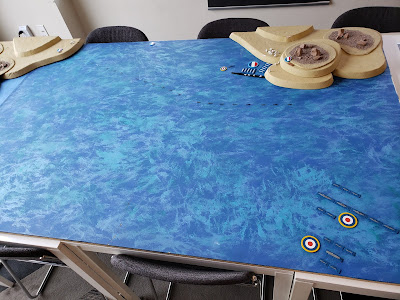French Deployment
For the coming battle, since I am teaching and running the game I will command all of the French destroyers in both the Mers-el-Kebir anchorage and off-map in Oran Harbor, as well as the coastal batteries, and the seaplane carrier Commandant Teste. Andy, sharing the French with me, will take the four French capital ships. We were restricted to the historical arrangement of ships in the anchorage, in which notably all of our vessels are moored with their sterns to the pier. Although they have built up steam during the negotiations, a rapid departure still entails a significant risk of collision, and the guns of the battlecruisers Dunkerque and Strasbourg are all concentrated in two forward turrets, pointing away from the British!
An aerial photograph of the anchorage at Mers-el-Kebir before the attack.
Large Destroyers, from left: Le Terrible, Kersaint, Lynx, Tigre, Volta, and Mogador
Capital ships, from left: Dunkerque, Provence, Strasbourg, Bretagne, and Commandant Teste
Capital ships, from left: Dunkerque, Provence, Strasbourg, Bretagne, and Commandant Teste
British Deployment
Command of Force H is similarly split, with Ted aboard HMS Hood leading the cruisers Enterprise and Arethusa, all fast enough to keep pace with the modern French battlecruisers, while Edwin commands the slower battleships Valiant and Resolution. Each of them each also has three destroyers as escorts, with the remainder screening Ark Royal somewhere to the rear. Allowed to deploy freely as long as they remain outside the perimeter of the defensive minefields, Ted and Edwin decide on an aggressive approach to maximize their initial advantage, opening fire at 13,500 yards (historically the British bombardment was conducted at 17,500 yards).
Force H from left: HMS Resolution, Valiant, Enterprise, Hood, Arethusa
Battle Begins
Because the onus is on the British to begin the engagement, I have decided that the first round of the scenario skips movement and begins with gunnery. Having settled on their tactics, Ted and Edwin open fire! Their choice of targets highlights their game plan: with all three heavies aiming at the two battlecruisers despite the penalty for doubling up, they clearly aim to hamstring any attempt to escape.
Initial salvos concentrate on Dunkerque and Strasbourg.
Their determined target selection pays immediate dividends, with good dice rolls and bonuses for firing first at stationary targets resulting in numerous penetrating hits on both capital ships! A fire also breaks out aboard Commandant Teste after a 6" shell strikes her. The French response is limited to the stern "X" and "Y" turrets of Provence and Bretagne and the battlecruisers' secondaries. The older, smaller-caliber dreadnought guns have poor odds of penetrating the British armor at this range, so Andy targets the cruisers instead to hopefully put them out of action quickly.
Chaos in the anchorage as shells crash among the ships and guns roar in response.
French return fire damages HMS Arethusa, and, what's that? Hood is burning!
In the second round, the ships begin moving across the table. The numbers on the wake tokens track the current speed of ships or formations, with each 1" of movement representing 5 knots. There is a risk of collision if ship bases overlap, so players will have to carefully consider their pre-plotted, simultaneous movement. Due to their greater maneuverability, I allow the escorting DDs to simply tag along with their charges so that the other players can learn the basics controlling a few ships, while I manage the large French destroyer flotilla.
French ships clear their moorings while an ominous cloud of smoke trails behind the British flagship...
The gunnery exchange continues, with heavy 15" guns single-mindedly pounding the French battlecruisers. Dunkerque's superfiring "B" turret is destroyed, robbing her of half her firepower, and both sister ships lose hull boxes and secondary turrets. Aviation gas spreads flame across their decks from ruined floatplane hangars, and stray shells start fires in several shore facilities as well. Force H's cruisers suffer too, but HMS Hood's damage control parties are able to extinguish the fire aboard her, and with the French unable to bring much of their firepower to bear, the contest at this stage is decidedly unequal.
Smoke from burning ships obscures much of the harbor.
Disaster! In the rush to escape, Bretagne collides with the badly-damaged Dunkerque, sealing the latter's fate!
The loss of Dunkerque is a serious blow to the French. Together, she and Strasbourg posed a serious challenge for the British to catch and defeat in open water, and would have forced Ted to keep HMS Hood with the slower battleships, but her loss gives Force H greater freedom of action to counter any breakout attempt by the remaining ships. Strasbourg has also taken moderate damage, with minor damage to Commandant Teste and Bretagne. For the British, the only damage worthy of note is that suffered by the leading cruiser Arethusa, which has been effectively mission-killed with the loss of all three of her turrets and one of her engine rooms.
At this point, although my team is taking a pounding, I have to say I'm quite proud of how the scenario is playing out. The British bombardment plunged the harbor into chaos historically, with several ships being run aground to prevent them from sinking, and the situation in our game is similarly disruptive!
The British don't get to have it all their way, though. Each round more French ships get under way, and the close approach that Ted and Edwin planned to maximize their firepower leaves them deep inside our threat envelope as well. Historically, the British force ceased fire at about this time and pulled back to observe the situation, but our opponents' course has committed to them to several more rounds of combat and given the French destroyers present an opportunity to close the range.
The table at the end of round 4.

















